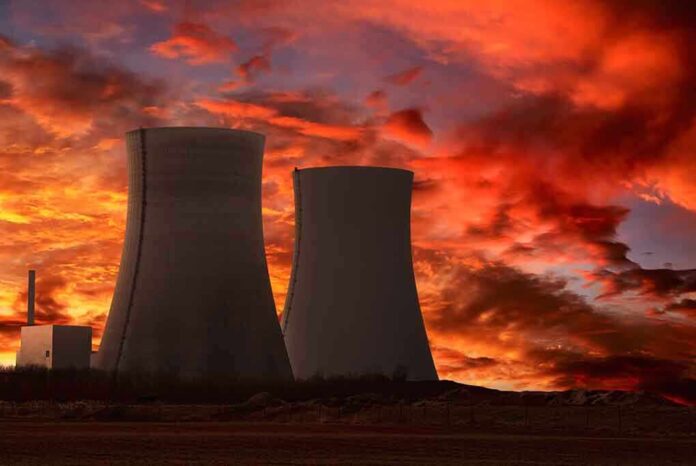Russia’s calculated manipulation of Europe’s largest nuclear power plant has created an unprecedented catastrophe scenario that threatens millions across the continent—and the international community has largely looked the other way.
Quick Take
- Russia controls Ukraine’s Zaporizhzhia Nuclear Power Plant and is actively attempting to divert its power supply to the Russian grid while cutting Ukrainian access, creating persistent nuclear safety risks.
- The facility’s six reactors require constant cooling despite being in cold shutdown, but now depend primarily on emergency diesel generators—equipment designed only for temporary backup, not indefinite operation.
- Since the invasion began in March 2022, the plant has lost external power ten times, forcing Ukrainian workers to conduct 42 emergency repairs under fire.
- October 2025 brought rare good news when external power was restored through IAEA-mediated cooperation, but experts warn this temporary reprieve doesn’t address Russia’s underlying strategy to weaponize the facility.
- If diesel generators fail or fuel runs out—realistic scenarios in active warfare—a catastrophic nuclear incident could devastate Ukraine and contaminate the broader European region.
Russia’s Nuclear Hostage Strategy
Russia seized Europe’s largest nuclear facility during the opening days of its 2022 invasion, transforming the Zaporizhzhia plant into a military fortress stocked with weapons, mines, and troops. The plant, located in Energodar with a population of 50,000, sits strategically on the Dnipro River. Russian forces have fortified the perimeter and used its grounds to conduct military operations, all while manipulating the facility’s power supply to advance their strategic objectives against Ukraine’s energy grid.
Deliberate Power Manipulation Creates Escalating Crisis
Nuclear expert Mykhailo Shuster revealed Russia’s explicit strategy: the nation seeks to disconnect the plant from Ukraine’s power network in order to connect it to Russia’s grid—a “long-stated ambition.” Russia maintains “a high level of readiness” to execute this connection, contingent on interrupting Ukrainian power supply. This isn’t accidental collateral damage from warfare; it’s deliberate infrastructure manipulation designed to steal Ukrainian energy resources while creating nuclear safety chaos.
Since August 2022, military action has severed all off-site power to the plant eight times. By October 2025, the facility experienced ten complete external power blackouts. Each outage forced the plant to rely entirely on emergency diesel generators—equipment engineered as a “last line of defence” for temporary emergencies, not permanent operation. Ukrainian energy workers have been forced to conduct 42 emergency repairs to power lines since the invasion began, risking their lives under Russian fire.
The Generator Gamble: Equipment Operating Beyond Design Limits
All six reactors at Zaporizhzhia are in cold shutdown, meaning they’re not generating power. However, cold shutdown doesn’t mean safe inactivity—the reactors and spent fuel require constant cooling to prevent catastrophic overheating. IAEA Director General Rafael Grossi emphasized the fundamental danger: “Emergency diesel generators were designed to be the ‘last line of defence’ to help nuclear power plants cool their reactors, but their use was now ‘an all too common occurrence.'” When equipment designed for temporary backup becomes the permanent cooling mechanism, the system operates in a state of perpetual emergency.
If diesel generators fail, fuel becomes unavailable, or maintenance cannot be performed—all realistic risks in an active war zone—the reactors and spent fuel pools cannot be cooled. This creates the potential for a catastrophic nuclear incident affecting not only Ukraine but the broader European region. Zaporizhzhia ranks among the world’s ten largest nuclear plants by capacity, magnifying the potential scope of any disaster.
October Breakthrough Amid Ongoing Peril
On October 23, 2025, Ukraine’s Energy Minister Svitlana Grynchuk announced that the damaged 750-kilovolt Dniprovska transmission line linking the plant to Ukraine’s grid had been repaired, restoring off-site power after a month-long outage. This represented the first major positive development in the escalating crisis. Work continues on the Ferosplavna 330-kilovolt backup line that runs through Russian-held territory. Critically, the repairs occurred under a local ceasefire brokered by the IAEA—a rare instance of Russian-Ukrainian cooperation.
IAEA Director Grossi characterized the moment carefully: “Both sides engaged constructively with the IAEA to enable the complex repair plan to proceed,” describing the restoration as “a key step for nuclear safety.” However, he cautioned that temporary progress obscures the persistent threat: “As long as this devastating conflict goes on, nuclear safety and security remains under severe threat. Today, we had some rare positive news to report, but we are far from being out of the woods yet.”
Weaponization of Nuclear Infrastructure Sets Dangerous Precedent
The situation reveals a critical failure of international nuclear safety enforcement. Russia has deliberately used a civilian nuclear facility as a military fortress and energy manipulation tool during active warfare. This violates established international nuclear safety protocols. Yet the international community, despite clear evidence of strategic weaponization, has largely accepted the status quo rather than treating it as the emergency it represents. Putin has shown no willingness to relinquish control, and international peers have treated control of a nuclear power plant as a negotiable military asset rather than an inviolable humanitarian concern.
This precedent is dangerous. It signals to nuclear-armed nations that weaponizing civilian nuclear infrastructure during conflicts carries minimal diplomatic or military consequences. As long as the plant remains under Russian military control and subject to active military targeting, genuine nuclear safety cannot be assured. The dependency on emergency diesel generators as the primary cooling mechanism represents an untenable long-term situation—one that could result in catastrophic consequences extending far beyond Ukraine’s borders and establishing a new, terrifying normal for nuclear security in an era of great power conflict.
Sources:
Russia Is Risking Nuclear Catastrophe With Attempts to Siphon Power From Ukraine’s Biggest Plant
Ukraine’s Zaporizhzhia Nuclear Plant to Regain Off-Site Power, Officials Say











